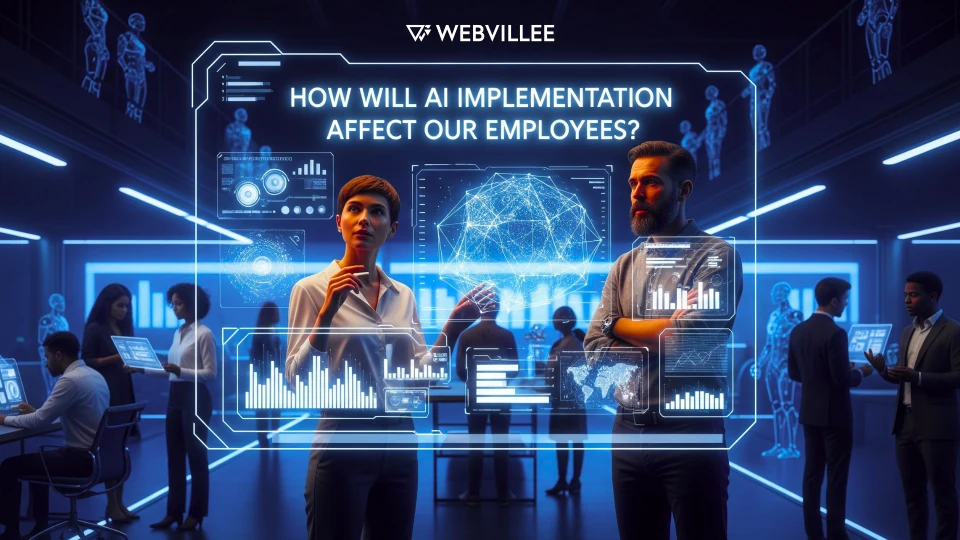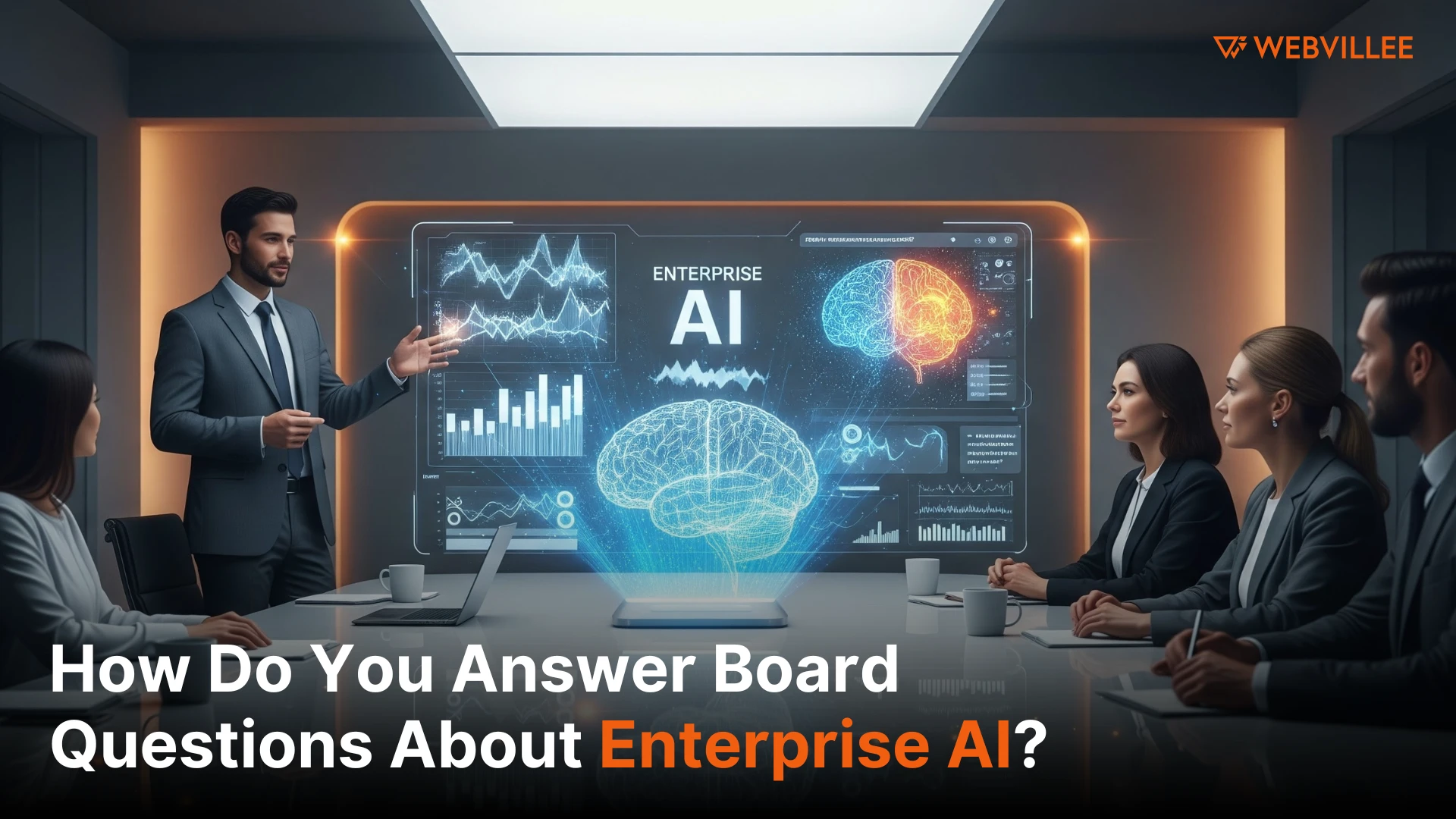Preparing for the Boardroom AI Conversation
Board questions about enterprise AI focus on ROI, risk, timeline, and competitive impact before approving significant technology investments. These questions reflect fiduciary responsibility and require data backed answers, not enthusiasm about AI’s potential.
Understanding what your board will ask allows you to prepare compelling responses. Most board members lack deep technical knowledge but possess sharp business instincts and financial acumen.
This guide covers the 9 most common board questions about enterprise AI and how to answer them with the clarity, specificity, and risk awareness that earns executive approval and AI investment decisions.
Q1. What Is Our Expected ROI from AI Implementation?
Boards require specific financial projections with clear timeframes and measurable outcomes, not promises of improved efficiency or innovation. Your AI ROI calculation must connect technology investment to concrete business results.
Start with quantifiable benefits. If AI will reduce customer service costs by handling 40% of inquiries, calculate annual savings based on current support expenses. If it will increase sales conversion by 15%, project additional revenue based on current traffic and average deal size.
ROI calculation components:
- Direct cost savings from automated processes
- Revenue increases from improved conversion or new capabilities
- Productivity gains measured in FTE equivalents
- Error reduction savings from improved accuracy
Return on investment timelines matter as much as percentages. A 300% ROI sounds impressive until you reveal it requires five years to achieve. Boards prefer modest returns with shorter payback periods over ambitious projections requiring extended timeframes.
Break financial projections into phases. Show expected benefits after six months, one year, and two years. Early wins build confidence while long term gains justify continued investment. This phased approach also acknowledges that AI implementations rarely deliver full value immediately.
Q2. How Much Will This AI Initiative Actually Cost?
Total enterprise AI costs include implementation, infrastructure, training, and ongoing maintenance that extend far beyond initial licensing fees. Your AI implementation budget must account for all expenses across multiple years.
Implementation costs cover software licenses, integration work, data preparation, and consulting fees. These upfront expenses are visible and typically included in initial budgets. The challenge is accurately estimating the effort required for data cleaning and system integration.
Complete cost breakdown:
- Software licenses and platform fees
- Cloud infrastructure and computing resources
- Implementation consulting and integration work
- Internal staff time for project management and testing
- Data preparation and quality improvement
- Employee training and change management
- Ongoing maintenance and support
- Model retraining and performance monitoring
Hidden costs emerge during implementation. Data quality issues require more cleanup than anticipated. Legacy system integration proves more complex than initial assessments suggested. User adoption challenges necessitate additional training and support.
Infrastructure expenses continue monthly. AI workloads require significant computing power, especially for training models. Cloud costs for GPU instances, storage, and data transfer add up quickly. Budget for infrastructure scaling as usage grows.
Maintenance represents ongoing investment. Models require retraining as data patterns shift. Systems need updates for security and compatibility. Support staff must monitor performance and address issues. Annual maintenance typically costs 15 to 25% of initial implementation spend.

Q3. What Are the Risks of AI Implementation Failure?
Boards want to understand technical, operational, and reputational AI implementation risks before committing resources to initiatives that might not deliver promised results. Risk mitigation strategies demonstrate thoughtful planning.
Technical risks include model performance below expectations, integration challenges with existing systems, and data quality insufficient for training. These risks can delay timelines and increase costs significantly.
Risk categories to address:
- Technical failure where AI doesn’t achieve accuracy targets
- Operational disruption during implementation and transition
- Budget overruns from underestimated complexity
- Reputational damage from AI errors affecting customers
- Regulatory compliance issues with data usage
- Vendor dependency creating long term lock in
Operational risks focus on business continuity. If AI implementation disrupts critical processes or requires extended downtime, the cost might exceed benefits. Phased rollouts and parallel operation mitigate these risks by allowing gradual transition.
Reputational exposure concerns boards particularly. AI errors visible to customers damage trust and brand perception. A chatbot providing incorrect information or a recommendation engine suggesting inappropriate products creates public relations problems that outlast the technical fix.
Failure scenarios need honest assessment. What happens if the AI doesn’t achieve target accuracy? How do you handle deployment delays? What’s the fallback if adoption rates remain low? Having contingency plans shows risk awareness that boards appreciate.
Q4. Do We Have the Right Team and Skills for AI?
AI success depends on having or acquiring specialized AI skills and expertise that most organizations lack internally. Honest assessment of team capabilities prevents failed implementations blamed on technology when the real issue was insufficient talent.
Current team evaluation starts with inventory. Do you have data scientists who can develop and train models? Engineers who can deploy and maintain AI systems? Product managers who understand AI capabilities and limitations? Most organizations discover significant skill gaps.
Critical skill requirements:
- Data scientists for model development and training
- ML engineers for deployment and scaling
- Data engineers for pipeline and infrastructure
- AI product managers for requirements and strategy
- Change management specialists for adoption
Talent acquisition proves challenging in competitive markets. Experienced AI practitioners command premium salaries and have many opportunities. Hiring timelines extend 6 to 12 months for specialized roles. Budget accordingly for both compensation and recruiting costs.
Training existing staff provides an alternative to hiring. Upskilling engineers in machine learning or training analysts in data science takes time but builds internal capability. Online courses and bootcamps accelerate learning but can’t replace hands on experience.
Vendor partnerships fill immediate gaps while building internal expertise. Working with experienced AI consultants or implementation partners transfers knowledge to your team. This approach combines external expertise with internal capability development for sustainable long term success.
Q5. How Will AI Implementation Affect Our Employees?
Boards care about AI workforce impact, organizational readiness, and change management because employee concerns can derail even technically sound initiatives. Addressing human factors early prevents resistance that slows adoption.
Job changes from AI range from task automation to role elimination. Be direct about which positions will change and how. Employee training helps workers adapt to new responsibilities when AI handles routine tasks. Transparency builds trust even when news is difficult.
Workforce considerations:
- Roles that will change or be eliminated
- New positions required for AI management
- Skills training needed for affected employees
- Timeline for workforce transition
- Communication plan for organizational change
Change management requires dedicated effort and resources. Employees comfortable with current processes often resist new systems, especially when AI replaces familiar workflows. Early involvement, clear communication, and adequate training reduce resistance.
Training needs extend beyond technical skills. Employees must understand when to trust AI recommendations and when to apply human judgment. They need comfort with new interfaces and workflows. Budget time and resources for comprehensive training programs, not just brief orientation sessions.
Resistance management acknowledges legitimate concerns. Workers fear AI will eliminate their jobs or make their expertise obsolete. Address these concerns honestly while explaining how AI augments rather than replaces human capabilities in most implementations.

Q6. What Data Privacy and Security Risks Does AI Create?
AI amplifies data concerns through processing scale and regulatory scrutiny that expose organizations to privacy violations and security breaches. AI data security requires comprehensive policies and technical safeguards.
Privacy compliance becomes more complex with AI. Regulations like GDPR and CCPA impose strict requirements on automated decision making and data processing. AI systems that process personal information must provide transparency, allow user control, and demonstrate fairness.
Security and privacy requirements:
- Data encryption for information used in training and inference
- Access controls limiting who can use AI systems
- Audit logs tracking all AI decisions and data usage
- Model security preventing extraction or manipulation
- Compliance with industry specific regulations
- Data governance policies for AI development
Data governance establishes rules for collecting, storing, and using information in AI systems. Which data can be used for training? How long should it be retained? Who approves new data sources? Clear policies prevent compliance violations and security incidents.
Security measures protect both data and models. Adversarial attacks can manipulate AI behavior through carefully crafted inputs. Model theft allows competitors to replicate your AI capabilities. Robust security architecture addresses these AI specific threats beyond traditional cybersecurity.
Regulatory compliance varies by industry and geography. Healthcare AI must meet HIPAA requirements. Financial services face additional scrutiny on algorithmic decision making. International deployments must address data localization and transfer restrictions.
Q7. How Long Will Implementation Take and What Are the Milestones?
Realistic AI implementation timeline with measurable project milestones demonstrates planning rigor and allows boards to track progress against expectations. Overly optimistic schedules damage credibility when delays inevitably occur.
Implementation phases typically include discovery, data preparation, model development, testing, and deployment. Each phase has specific deliverables and success criteria. Digital Transformation initiatives like AI require careful sequencing to manage risk and maintain momentum.
Typical timeline structure:
- Discovery and planning (4-8 weeks): Requirements definition, data assessment, architecture design
- Data preparation (8-12 weeks): Collection, cleaning, labeling, pipeline development
- Model development (12-16 weeks): Training, testing, refinement, validation
- Integration and testing (8-12 weeks): System integration, UAT, performance validation
- Deployment and monitoring (4-8 weeks): Rollout, user training, performance tracking
Deployment phases allow incremental value delivery. Start with a pilot in one department or use case. Expand to additional areas after proving value and refining the approach. This phased rollout reduces risk and provides learning opportunities.
Success metrics define what good looks like at each milestone. Accuracy targets for models, performance benchmarks for systems, adoption rates for users, and business impact measures for outcomes. Clear metrics prevent scope creep and keep teams focused on objectives.
Buffer time accounts for unexpected challenges. Data quality issues, integration complications, and adoption hurdles extend timelines. Adding 20 to 30% contingency to estimates provides realistic schedules that you can actually meet.
Q8. Are Our Competitors Already Using AI?
Competitive context determines urgency and strategic necessity because AI competitive advantage or disadvantage directly affects market position and growth prospects. Understanding where your industry stands with AI adoption informs investment timing.
Market positioning analysis reveals whether you’re leading, keeping pace, or falling behind. Leaders gain first mover advantages but bear higher costs and risks. Fast followers learn from pioneer mistakes while maintaining competitive position.
Competitive assessment areas:
- Which competitors have deployed AI capabilities
- What specific use cases and business functions they’re addressing
- Visible results or performance improvements they’ve achieved
- Industry benchmarks for AI adoption in your sector
- Emerging AI capabilities that could disrupt your market
Competitor analysis should be specific. General statements that everyone is using AI don’t help. Identify which competitors have deployed customer service chatbots, implemented recommendation engines, or automated specific processes. Understand how these capabilities affect their cost structure or customer experience.
First mover advantages depend on the use case. In rapidly evolving markets where AI creates new capabilities, early adoption can establish market position. In mature markets where AI improves existing processes, fast follower strategies often make more sense.
Industry benchmarks provide context beyond direct competitors. What percentage of companies in your sector have adopted AI? What use cases see the highest adoption? Where are early results most promising? This broader view prevents overreacting to individual competitor moves.

Q9. What Happens If We Don’t Invest in AI Now?
Boards need to understand the cost of not adopting AI and accumulating competitive disadvantage that threatens long term viability. Opportunity cost and market share risk make inaction expensive even when not immediately visible.
Competitive disadvantage compounds over time. Competitors using AI to reduce costs, improve customer experience, or accelerate innovation gradually widen their advantage. What starts as a small efficiency gap becomes a structural cost disadvantage that’s difficult to overcome.
Consequences of inaction:
- Declining margins as AI adopting competitors operate more efficiently
- Customer defection to competitors offering superior AI powered experiences
- Talent loss to organizations working with modern technology
- Market share erosion in segments where AI creates advantages
- Increasing catch up costs as the AI capability gap widens
Opportunity cost represents foregone improvements and innovations. Every month without AI powered customer service extends response times and limits support capacity. Each quarter without predictive analytics means decisions made on intuition rather than data driven insight.
Market share risk varies by competitive intensity. In highly competitive markets where AI creates customer facing advantages, delays in adoption directly threaten revenue. In less competitive or regulated industries, the urgency may be lower but the long term risk remains.
Capability gaps become harder to close over time. Organizations that start AI initiatives today build expertise, accumulate training data, and develop processes that create compounding advantages. Waiting means starting further behind with steeper learning curves.
How Should You Prepare for the Board Conversation?
Successful board presentation AI discussions combine data driven answers, clear risk mitigation plans, and realistic timelines that demonstrate executive communication and thorough preparation. Boards approve initiatives they understand and trust.
Preparation starts with anticipating questions and developing specific answers. Vague responses about AI’s transformative potential don’t satisfy boards. They want numbers, timelines, and risk assessments.
Preparation checklist:
- Financial analysis: Complete ROI calculations with sensitivity analysis showing best, expected, and worst case scenarios
- Competitive research: Document specific competitor AI initiatives and industry adoption trends
- Risk assessment: Identify top risks with probability, impact, and mitigation plans for each
- Implementation plan: Detailed timeline with phases, milestones, and resource requirements
- Team evaluation: Honest assessment of capabilities with hiring or partnership plans for gaps
- Success metrics: Clear KPIs for measuring AI performance and business impact
Supporting materials should be concise but comprehensive. Prepare a brief presentation covering key points with detailed appendices addressing technical questions. Financial models showing ROI calculations, competitive analyses, and implementation Gantt charts provide backup for board members who want deeper detail.
Presentation tips focus on clarity over complexity. Avoid technical jargon and AI terminology boards won’t understand. Frame everything in business terms: revenue impact, cost reduction, risk mitigation, and competitive position. Use analogies to explain complex concepts when necessary.
Practice answers to likely follow up questions. Boards probe assumptions in financial models, challenge timeline optimism, and question capability assessments. Thoughtful responses to tough questions build confidence in your planning more than polished presentations.
Earning Board Approval for AI Initiatives
Board questions about enterprise AI focus on financial returns, implementation risks, organizational readiness, and competitive necessity because these factors determine whether AI investments make business sense. Answering these questions requires moving beyond technology enthusiasm to rigorous business analysis.
The 9 questions covered here represent the core concerns boards address before approving significant technology investments. ROI calculations, cost assessments, risk evaluations, and competitive analyses provide the foundation for informed decisions.
Enterprise AI strategy succeeds when technology initiatives align with business objectives and address board concerns proactively. Organizations that prepare thoroughly, communicate clearly, and demonstrate planning rigor secure the AI adoption planning investment and executive support needed for successful implementation.
Ready to develop your AI business case and implementation strategy? Get in touch with Webvillee to explore solutions that address both technical requirements and board governance needs.

